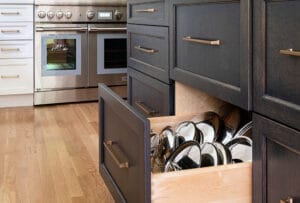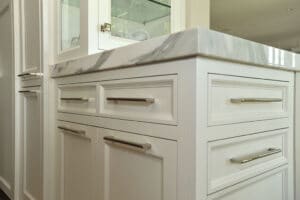At Metropolitan Countertops & Cabinets, we take pride in the beautiful, custom cabinets and countertops we create for clients. So we created a step-by-step guide on cleaning cabinet doors.
When it comes to custom, a large part of the experience you’ll be looking for comes from the thing that people see first, the cabinet door. Whether in your kitchen, bathroom, or another room in your house, the cabinet doors can be a tricky part of a home to keep clean. They have a lot of nooks and crannies and other spaces where dirt and dust can easily accumulate. Thankfully, you can make your life easier by taking the time to clean your cabinet doors. If you clean the doors with the right techniques, the work will become a lot easier and faster.

Steps for cleaning kitchen or bathroom cabinet doors
Step 1: Empty them out
This might seem basic, or to some, dumb. But an empty cabinet is easier to clean than one packed with glassware or towels. It allows you the extra room and leverage to get into the nooks and crannies of the cabinet surface without having to take those cupboard doors off the hinges. Also, if you have the time, cleaning cabinet doors is less dramatic if done over a few days.
Step 2: Mix up a gentle cleanser
Like most people, you probably use your kitchen (or bathroom) every day. With all that cooking you are bound to eventually see grease stains and other muck on your kitchen cabinet doors. We get this question a lot: What about tacky grease spots on wooden cabinets?
When cleaning, use a mild detergent and water solution to remove dirt, dust and grease that buildup with routine usage. Be sure to use warm water to help break down any grime, but avoid super hot water as in some cases it can damage the finish.
Make sure to wipe up all the water, since any water left on the cabinets can seep into the wood and cause warping over time.
Step 3: Tackle the tops
Ideally, you want to start at the top and work your way down.
When cabinets are not ceiling height, try on a step stool or ladder.
If the cabinet is just dusty, use a long-handled duster or small round brush of vacuum cleaner to clean it.
Step 4: Treat the trim
There might be some areas that give put up more of a fight than others. One of those areas will probably be the trim.
Step 5: Get the glass gleaming
It’s hard to beat Windex… The commercial glass cleaner has been around for a long time and is a great option for any glass in your home, as we’re sure you know. But, you can create a homemade spray solution for glass-fronted cabinet doors using one cup of rubbing alcohol, one cup of water, and one tablespoon of vinegar.
Either of those options will have your glass-fronted cabinets shining!
The Shortlist: We asked Conestoga, America’s leading supplier of custom wood cabinet doors, to tell us about the do’s and don’ts for cleaning wood cabinet doors.

DO’S
- Do periodically clean cabinets with a mild detergent and water solution to remove dirt, dust and grease that buildup with routine usage
- Do dampen a soft, non-abrasive cloth and wipe entire exterior surface of cabinetry and dry with a soft cloth
DON’TS
- Don’t use a wet cloth that allows water to run down the cabinetry and always dry your kitchen cabinet door immediately if water is spilled onto the surface
- Don’t use abrasive cleansers, ammonia or any other type of harsh chemical. These cleaning agents may cause discoloration, scratching, marring and dulling of the finish
- Don’t use furniture polishes and waxes on finished cabinetry. Furniture polishes alter the original sheen level and may leave a film on the surface that attracts dust and dirt. These polishes may also cause an irregular or blotchy appearance because they are unable to stand up to many common kitchen stains
Don’t use an abrasive cleaner, ammonia, or any other type of harsh chemical on painted wood cabinets. The use of these household cleaners that can be found in most kitchens may come at a cost. Just know they have the potential of causing some damage to the original finish. Some chemicals can make your cabinet doors dull and could cause discoloration and marring, as well as give off an unpleasant odor.
Don’t use furniture polishes and waxes on finished cabinetry. Some furniture polishes change the original level of finish and leave a film that may attract more dust and dirt. These polishes may also cause a speckled, uneven, patchy appearance because they’re not able to stand up to common kitchen stains.
Don’t soak wood cabinet doors in cleaning agents. This can cause warping and cracking. Instead, use a spray bottle with a cleaning agent on clean, soft cloths and gently wipe the cabinets.
Don’t use steel wool to attack stubborn stains on greasy cabinets as it can damage the cabinet finish